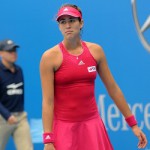 For several months, Garbiñe Muguruza lives a new reality, palpable far beyond the tennis courts. Her media profile has increased -Forbes magazine included her in January among the 30 most influential European figures with less than 30 years, her market value has been enhanced exponentially -now is a magnet for large sponsors- and even geographically has given way with the transfer of her residence from Barcelona to Geneva (Switzerland), where her trainer can exercise her at full capacity, like so many other elite athletes.
For several months, Garbiñe Muguruza lives a new reality, palpable far beyond the tennis courts. Her media profile has increased -Forbes magazine included her in January among the 30 most influential European figures with less than 30 years, her market value has been enhanced exponentially -now is a magnet for large sponsors- and even geographically has given way with the transfer of her residence from Barcelona to Geneva (Switzerland), where her trainer can exercise her at full capacity, like so many other elite athletes.
Absolutely everything has changed for her, treated today in the circuit as one of the great figures, with the luxuries and entertainments that it entails. Gone are the days of promise and staying in the background, to walk down the street without anyone asking for an autograph or a photo. Now, in Paris, where she is already treading the quarterfinals after beating the experienced Svetlana Kuznetsova (6-3, 6-3 in 1h 38m).
Muguruza has the opportunity to cross the barrier that stopped her for the last two years at Roland Garros. However, this course was not exactly a bed of roses. Her new reference condition, as an icon, requires her to play with extra weight. Something she knew beforehand, but that made her go through difficult times. “The first year was difficult, the start from scratch after the madness, but you have to forget everything you’ve done and put your feet on the ground. “That’s what I’m getting better, and shows all that out of my head,” she added.
The pressure has become her inseparable traveling companion. The plus of stress and tension. Well aware, she knows that to grow and become the number one, it is essential to bear it all. She herself, in an exercise of sincerity that was framed by the Higher Sports Council (CSD), on 27 November in Madrid, was the one who raised the bar: “Before it was Garbiñe who could win, but now I will be the Garbiñe that should win. It’s something I have to assimilate, because I manage myself. No one can teach you to handle these things. “
Except the parentheses of the Federation Cup and the Rome Masters (semifinals), the first third of 2016 was as a perfect setting for the player. She fell in the third round in Melbourne in the first in Brisbane, Dubai and Indian Wells, and the second in Stuttgart and Madrid. What have you learned from all that, Garbiñe? “My mind, my way of perceiving the games, how to prepare, and be prepared for the important moments and know how to play them. All this is what has helped me to have more experience and to be a better player. I’m much more prepared. “




